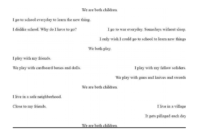Project Based Learning Lessons to Teach Point of View
By Dr. Jenniffer Pieratt
Students often live in silos with a lack of concern for others’ feelings, which leads to stark polarization in schools today. According to How to Build Empathy and Strengthen your School Community, Harvard researchers found that when young people have empathy, they display “more classroom engagement, higher academic achievement, better communication skills, lower likelihood of bullying, less aggressive behaviors and emotional disorders, and more positive relationships.” With the opportunity to develop empathy in every subject area, whether in history class or during an engineering project, educators should reaffirm empathetic response for students. Educators can incorporate this Two voice poem project into any subject to help students compare and contrast differing perspectives.
| Voice 1: _______________ (unique/different perspective) | Both Voices (what human traits are shared/in common) | Voice 2: _______________ (unique/different perspective) |
| … | … | … |
_________________________________________________________________________________________________________________
Creating a two voice poem is a versatile exercise which can serve as a final product in many different PBL contexts. I’ll walk you through three essential steps of a two voice poem project based learning lesson: elaborating a driving question, creating a specific set of benchmarks, and constructing a final product. Keep in mind that the ultimate aim is for students to gain perspective and learn about point of view – something that will truly help them in their personal life and career later on.
Start with a driving question
For this project based learning lesson, students should start by choosing a driving question that will push them to study point of view. Let’s face it: point of view matters. Studying different perspectives builds empathy and intellectual open-mindedness. Through this, students develop mutual understanding with their peers and learn to build thoughtful arguments. To formulate research questions which touch upon this, students can draw from a variety of sources for inspiration: historical and modern day celebrities, fictional characters, environmental issues, key political debates, etc.
Follow these benchmarks
Building a two voice poem, like all project based learning lessons, requires several steps which should be clearly outlined by the PBL facilitators. The first is for every student to do individual research on their chosen subject. When the pairs settle down to write their two voice poem, each student can write their individual part first, after which the two can come together to write the common lines. Color coding can come in very handy to make the structure of the poem obvious (for instance, a “red” voice opposing a “blue” voice with a “purple” voice in the middle). To clarify how the points of view differ in the poem, each set of partners can then fill out the following diagram:
Throughout this process, students should pay special attention to the contrasting experiences and emotions of the two voices. The dual narratives in the poem should be refined and emphasized through specific word choice, sensory language, and dialogue. Once this is done, students can practice reading the poem out loud together, each interpreting a voice. The lines they have in common should be rehearsed until the team can read them out in unison. When they’ve finished perfecting their final draft, the class can self-reflect through a literary analysis of the two voice poems. This final step in the writing process will definitely improve the quality of the final outcome.
The final product
At last, when the two voice poems have been completed, digital tools such as GarageBand or the Chrome Voice Recorder can be used to record each piece. The audio files can then be showcased in a listening station at an exhibition or linked to QR codes on a website. To bring this project based learning lesson to the next level, students can organize a poetry cafe reading and invite community members to whom they want to dedicate their event as tribute, as done in Lake Elementary School. One last interesting idea is that of resilience cafés, which connect historical stories of resilience (ex: figures in the Civil Rights movement) with resilient individuals in the community (ex: today’s African American rights activists) through spoken word poetry.
The power of dual narratives must not be underestimated. Empathy can play a key role in solving systemic problems of isolation and divisiveness. It’s easy to imagine how empowering a project based learning lesson based on a two voice poem could be for your students. Take ownership of your classroom by making students feel safe, valued and respected in their own skin.
To download this lesson click HERE. You can also check out more PBL Project Ideas here.


